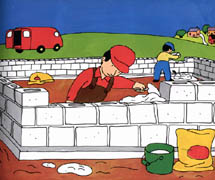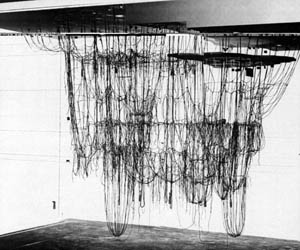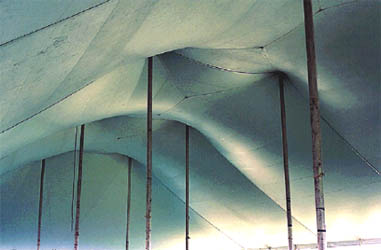Basic intuition / Intuition de base
| Mettre en contrastes trois types d’architecture et suggérer au lecteur d'opérer lui même la transposition : de n’y voir pas seulement des architectures mais des architectures de pensées, des modes de relation, des modes d’articulation, d’unités de bases elles aussi différentes et qui ont leur propre "mode opératoire". | Let us contrast three types of architecture and suggest the reader make the transposition himself : to see there not only architectures but architectures of thought, types of relationships, types of articulation, basic units that are different too and have their own "operational modes". |

Drawing from Byron BARTON
"Building a house"
© 1981 (Greenwillow Books, New York)
| The first, architecture from bottom up, works by piling things up, piling brick on brick, weight on weight. A sequential model, additive, divisible, the modification of a part does not alter the whole. Larger units form the listel or the joists supporting the floorboards. A structure with main walls where the surface is built at the same time as the structure itself. Rectilinear space, rules, compasses, levels. | La première, architecture du bas vers le haut, travaille par empilement, empilant brique sur brique, pesanteur sur pesanteur. Modèle séquentiel, additif, divisible, la modification d’une partie n’altère pas le tout. Des unités plus grandes forment les liteaux ou les poutrelles soutenant les planchers. Structure à murs porteurs où la surface se construit en même temps que la structure. Espace rectiligne, règles, compas, niveaux. |

Picture from J-F. PIRSON,
La structure et l’objet,
© 1984, p.61 fig. 59 Pierre Mardaga Ed.
| The second, Gaudi’s threads model, a study for the church of Colonia Güell. Another type of space, other connections, another architecture of thought. One need only turn the model to see the church. A model conceived from above, lines, attachments, weights, joints, laces, knots, structure without surface : it being a sort of absence, between the lines. From a unit to a dimension, the line, the crossings and intersections make three. A model of the totality, the weights are in perpetual relation, balancing and unbalancing themselves, the basic units are already relative, to touch one is to touch the others and all of them. A model constantly more complex, of excrescence on excrescences, a curved space where the ceiling goes to the ground and the ground to the ceiling. | La seconde, le modèle à fils de Gaudi, étude pour l’église de la Colonia Güell. Autre type d’espace, autres articulations, autre architecture de pensée. Il suffit de retourner le modèle pour voir l’église. Modèle conçu par le haut, lignes, attaches, poids, jointures, dentelles, noeuds, structure sans surface : celle-ci étant comme cette absence, entre les fils. D’une unité à une dimension, le fil, les croisements et entrecroisement en font trois. Modèle de la totalité, les poids sont en relation perpétuelle, s’équilibrent et se déséquilibrent, les unités de base sont déjà relatives, toucher à l’une c’est toucher à l’autre et au tout. Modèle de complexification constante, d’excroissances sur excroissances, espace courbe où le plafond va jusqu’au sol et le sol jusqu’au plafond. |

Picture from "Soft Surfaces"
© J. A. Juracek, 2000,
p.290, Thames & Hudson Ed.
| The third, a surface, a canvas, extended between (loosened and stretched) and subtended (in the proper sense) on stakes, of another nature than the canvas ; the surface is given straight off. Trimming, links, stretchers, stretching and fixing, rigging. Two forces oppose one another, upward, downward, and resist in this opposition, condensation and verticality of the stake, horizontality of the canvas and extension. | La troisième, surface, toile, tendue entre (détendue et distendue) et sous-tendue (au sens propre) par des pieux, d’une autre nature que la toile ; la surface est donnée d’emblée. Arrimage, anneaux, tendeurs, tendre et fixer, haubaner. Deux forces s’opposent, vers le haut, vers le bas, et résistent dans cette opposition, condensation et verticalité du pieu, horizontalité de la toile et étendue. |